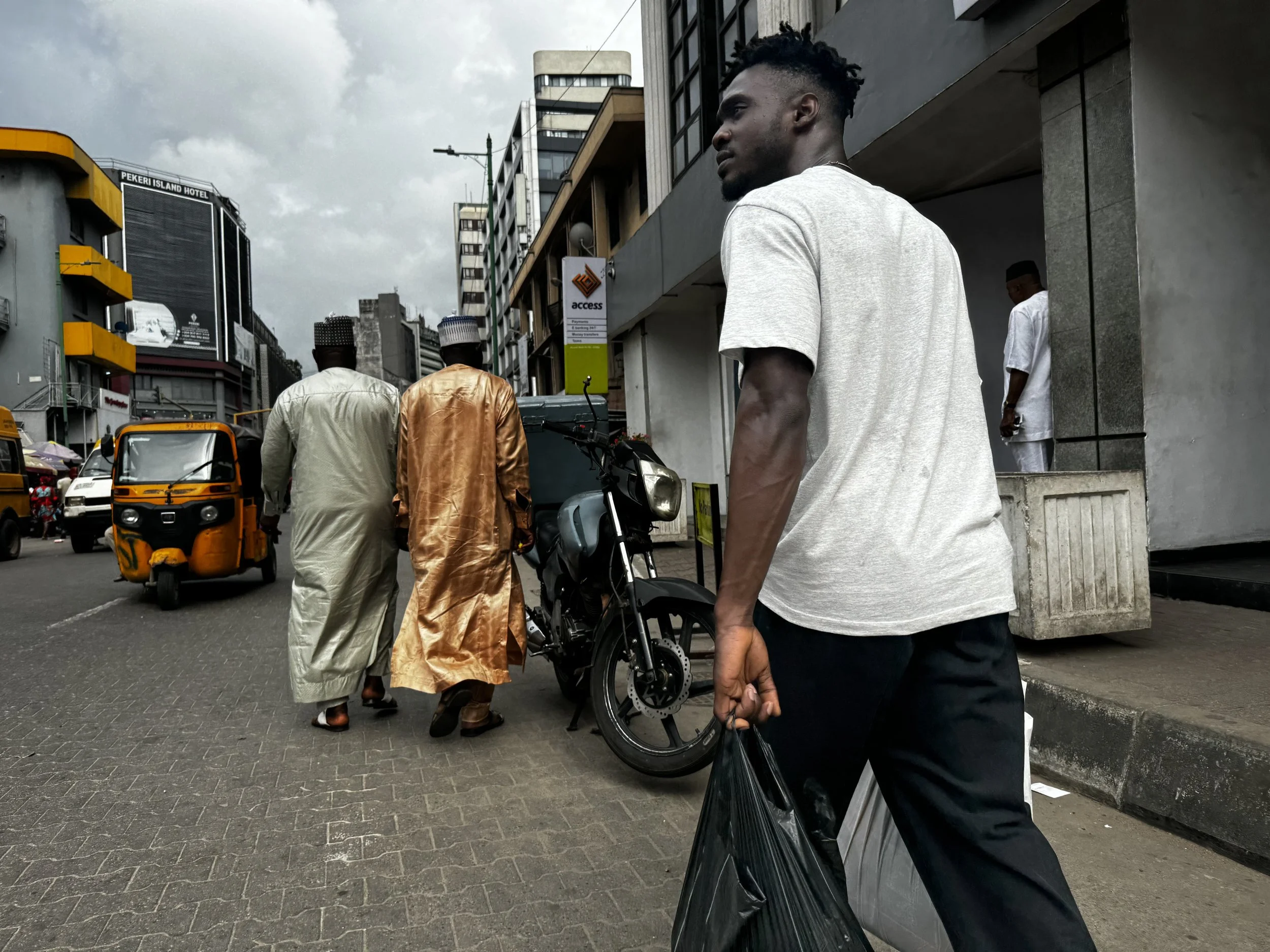118. JOY JULIUS: A SPACE BETWEEN CONTROL AND RELEASE.
A series of portraits by Joy Julius open M-A (A SPACE BETWEEN) issue 4. 'Lagos Market' is interspersed with imagery by Georges Seurat and Michaël Borremans; this cross-reference highlights notions of movement and pause, identity and purpose. Through the frame of Julius, we become a part of the noise of a busy street scene, scanning for signals...
Joy Julius, Lagos Market, 2024. From a series published within issue 4 of M-A (A SPACE BETWEEN). Image courtesy of Joy Julius.
‘The Lagos series was a chance to observe instead of create, to respond rather than control. But I think that sense of precision and care still comes through, just through a different medium. It was about finding my language, even in a space as layered and unpredictable as the Lagos market.’ J.J.
Joy Julius, Lagos Market, 2024. From a series published within issue 4 of M-A (A SPACE BETWEEN). Above image unpublished. Image courtesy of Joy Julius.
Please introduce your images from the Lagos market series.
This series began pretty instinctively. I didn’t set out with a big concept; I just decided to be present and document things that I felt drawn to every day while moving through Lagos. I kept noticing patterns, colours, people, how they moved, what they wore, the Danfos (vibrant yellow and orange buses) and the brightness of the fruits in the market. Over time, I realised I wasn’t just photographing a place, but a sensitivity, memory, nostalgia. Seeing through the lens of someone returning, someone in-between places, as someone from the diaspora.
I remember first seeing some images from this series when we were installing an exhibition together of 140 designers work at The Royal College of Art last summer - and I kept seeing these little orange buses and cars in amongst all the other images... and I didn't know it was your work at first, as I knew you as the person I remember meeting in tutorials and talking about tailoring... and then I remember becoming immediately very sure that I wanted to see everything from this series...this is an extraordinary series.
Yes definitely, especially coming from someone who knew me mainly through the lens of tailoring. I think people sometimes expect you to fit neatly into one thing, designer, photographer, stylist, but for me, those practices have always been connected. The Lagos series was a chance to observe instead of create, to respond rather than control. But I think that sense of precision and care still comes through, just through a different medium. It was about finding my language, even in a space as layered and unpredictable as the Lagos market.
Your work as a designer is very precise, you are very clear with what you want and yet this series of pictures seems to engage with your ability to distil a time in another context, also in a very specific way, but also in a way where you observed others...
That’s something I’ve thought about a lot. In design, I’m building a world, constructing silhouettes and creating systems. But with this work, I had to surrender a bit. Let the serendipity of events and surroundings guide me. I was stepping in and choosing to really see, not overthink, just trusting what I was drawn to and allowing instinct to lead.
I focused on details that struck me, without needing to justify why. I still looked for balance, texture, and mood. So even though I was simply observing, I was still composing, aiming to capture an image that felt right.
Shooting in the streets of Lagos, especially in the markets, also comes with its own risks. Photography isn’t always welcomed, so a lot of the time I had to hide the camera and just hope for the best. That tension between control and release, intention and chance, is something I think really lives in the series.
I have looked at these pictures over and over again and they seem to change each time. The compositional structure is extraordinary... What do these pictures mean to you?
I’ve spent a lot of my life moving between places. I hold on to memories of growing up in Nigeria, and those memories often show up in my work. But after being away for so long, I realised I was mostly using the same references as everyone else.
So I decided I needed to go back and do my own research. To move past just memories and really connect with what Nigeria feels like to me now. These pictures are part of that. They’re my way of documenting real, recent observations and reflecting on them in ways that continue to shape my work.
What are your signals for change?
Change usually shows up when something feels off, like I’m settling for less, or when something new catches my attention. I try to notice and trust those feelings, even if I don’t get them straight away. Often, I just need some time to sort things out clearly so I can keep moving my work forward. And usually, in the end, every change and shift makes sense.
Joy Julius, Lagos Market, 2024. From a series published within issue 4 of M-A (A SPACE BETWEEN). Still life image by Harry Nathan.
Joy Julius is a contributing artist to the 4th issue of M-A (A SPACE BETWEEN), available here along with 18 international stockists including The Serpentine, Village, Tender, Magalleria, Jeu de Paume and Dover Street Market.
With thanks to Zowie Broach.
M-A (A SPACE BETWEEN) will return with more interviews and contemplations in the autumn. Thank you for reading.



